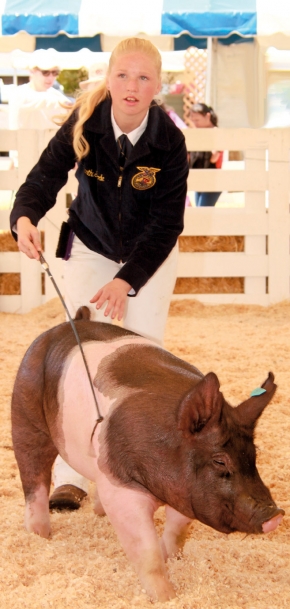Market Swine Program at Marin County Fair
According to John Taylor, who runs the Junior Livestock Market Swine program at the Marin County Fair, when his 15-year-old daughter Camilla goes looking for a young hog to raise for competition, she is looking for that elusive “it” factor.
“Oh, you just know it when you see that flashy pig,” says Taylor. That flashiness usually involves some combo of markings and color, personality and, of course, as these pigs are destined for auction on the final Sunday of the fair, you’re always looking for the propensity to put on healthy poundage.
“The sky is the limit for what type of pig a young person will want to choose,” Taylor says. “Some swine are special because they are all-white. Some are red. Some are crossbreed. They all have personalities, so when you pick them out, you take the time and look for whether they are perky and curious, or maybe playful. You look for that curb appeal.”
The Market Swine Program began four years ago and has drawn somewhere between 12 and 18 4-H-ers and FFA (Future Farmers of America) each year. Over the course of the year, a young person will pick out a young hog (according to Taylor most animals come from hog operations in Sonoma or the Central Valley), nurture, groom, feed and fatten that pig, and then bring it to show at the summer fair. Animals are first checked by a veterinarian and weighed in—they must weigh somewhere between 210 and 280 pounds. Participants then show their hogs in the ring and a judge ranks the animals from lowest to highest, including the highest award for a Grand Champion Swine. After the show and on the last Sunday of the fair, a public live auction is held and the animals are auctioned off.
“These kids are very forward looking,” says Taylor. “They work hard to raise one high-quality animal, and almost always get an above-market price at auction.” His daughter Camilla, for example, takes meticulous daily care of her animals. It is hard to find a certified organic hog to purchase, according to Taylor, but in Camilla’s case, as is the case with many of the contestants, everything her pig eats is organic. Camilla makes her own feed by going to bulk bins and carefully measuring a perfect blend of organic grains, then soaking that mixture in fresh milk from her family’s Bivalve Dairy north of Pt. Reyes Station.
Since it began, the swine program has been especially popular at the fair, attracting a lot of attention. Last year, Taylor recalls, a family came from San Francisco specifically to purchase a hog at the auction. “People really understand the hard work that these kids are doing over the course of the year to bring their animal to auction, and they are willing to pay for that,” says Taylor, adding that the junior entrants experience cause and effect when their animals sell above market price.
Of course the kids, including his own, grow attached to their animals, but they also have a clear understanding of the beginning and ending point of the project and the role their work and their animal play in a healthy food system. In a sense, says Taylor, the young competitors are emissaries for agriculture:
“These young people do such a good job raising and showing their animals, it is a great way to reach the public and put a face on the people behind where our food comes from.”




